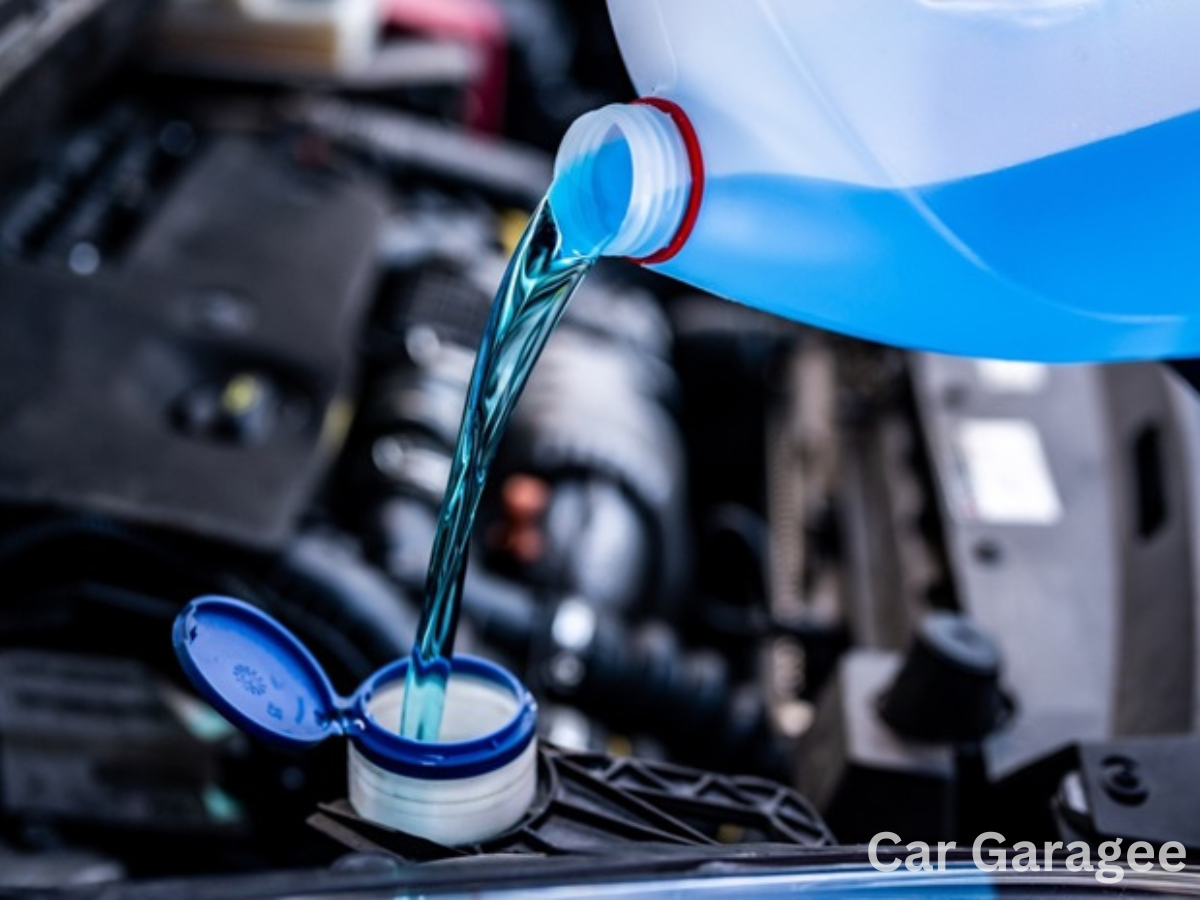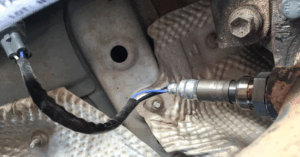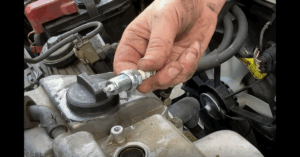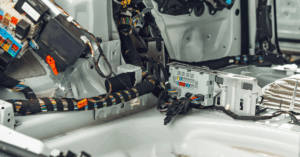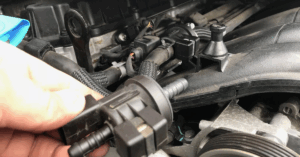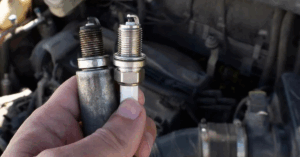Is your car losing coolant but no leak, no overheating in sight? It can be confusing and frustrating. Don’t worry, many drivers have this problem. In this blog, we’ll explain why your coolant might be vanishing and what you can do about it. Let’s find out how to fix this mystery and keep your car running great!
What Is the Purpose of Coolant?
The engine in your car gets very hot, with lots of small explosions happening every minute and metal parts moving super fast. It can get as hot as 195-220 degrees Fahrenheit, which is even hotter than boiling water! To prevent the engine from overheating and getting damaged, we need something to cool it down.
That’s where coolant comes in. Coolant is a mix of water and antifreeze. It moves through the engine, soaking up all the heat. Then, it goes to the radiator, where a fan blows the heat away, making the coolant cool again. This cool coolant goes back into the engine, and the process repeats.
Water in the coolant absorbs heat from the engine and helps cool it down. Antifreeze keeps the water from boiling when the engine is running and from freezing when it’s cold outside. It also has special stuff in it to stop parts from getting rusty. Water alone would boil and freeze, and antifreeze alone wouldn’t cool the engine well. But together, they work perfectly to keep the engine running smoothly.
If your car is losing coolant no leak no overheating, it might be hard to notice right away. Sometimes, you might be losing antifreeze but no leak is visible. It’s essential to check your coolant regularly to ensure your engine stays cool and works appropriately.
Losing Coolant But No Leak: What Are The Symptoms
Coolant, also known as antifreeze or radiator fluid, is essential for keeping your car’s engine cool. Sometimes, your car might be losing coolant even if there’s no visible leak. Here are some easy-to-spot signs that your car might be losing coolant without an apparent leak:
Low Coolant Level
If you check your coolant reservoir and see that the level is low or keeps dropping, your car might be losing coolant. It’s essential to regularly check and top off your coolant until you figure out what’s causing the problem.
White Exhaust Smoke
If you notice white smoke coming from your exhaust, it could mean that your car is losing coolant and it is getting into the engine and burning off. Pay attention to white smoke, especially when you start your car or speed up.
Engine Running Hot
If your engine is getting hotter than usual or your car’s fuel economy suddenly worsens, it could be a sign of low antifreeze with no visible leak. Watch for any changes in your engine’s behavior, as this can help you find the problem.
These symptoms can mean your car is losing coolant with no leak, but they might also point to other issues. It’s crucial to find out why your coolant is low, but there’s no leak. If you don’t, you could have serious engine damage that’s expensive to fix.
ALSO READ:
How do I Permanently Disable Anti Theft System
The Reason behind Red Light Blinking In Car
How long will a Car Run with a Bad Alternator?
Losing Coolant But No Leak: Where Is My Coolant Going?
It can be puzzling to see your car losing coolant without any visible leaks. But don’t worry, there are logical reasons for this. Here are some common causes:
Overfilled Coolant System
Overfilling the coolant system means adding too much coolant to the reservoir. When you put in more coolant than the system can handle, the extra coolant gets pushed out through the overflow tube. This can make it seem like your car is losing coolant, but there isn’t a visible leak.
When the engine heats up, the coolant expands. If there’s too much coolant, the pressure increases, and the system has to release the extra coolant to avoid damage. The overflow tube is designed to handle this, letting out the excess coolant to keep everything working correctly.
Knowing the correct coolant level is important to avoid overfilling. Look for the markings on the coolant reservoir. When the engine is cold, the coolant should be at the “COLD” or “MIN” line. If you add too much, the system will expel the extra coolant, which can cause confusion and make it seem like you’re losing coolant.
Regularly checking the coolant level can help you avoid overfilling. Make sure to do this when the engine is cool to get an accurate reading. Keeping the coolant at the right level helps your car’s cooling system work properly and prevents unnecessary coolant loss.
Internal Leaks
Sometimes, coolant leaks happen inside the engine, making them hard to spot. This can be due to a blown head gasket, a cracked cylinder head, damaged cylinder bores, or a leaking manifold. If coolant is getting into these areas, it can burn off or mix with engine oil, making it hard to see. These issues can cause serious engine damage if not fixed quickly.
Worn-out Radiator Cap
The radiator cap is crucial in maintaining the right pressure in the cooling system. Over time, it can wear out, letting coolant escape. A clogged radiator can also cause issues by blocking coolant flow. Check and replace the radiator cap if necessary to prevent losing coolant but no leak.
Engine Overheating
An overheated engine can cause coolant to evaporate, and low coolant can also lead to overheating. If you notice your engine running hotter than usual, check the coolant level and use a temperature gauge. If the engine is overheating, visit a mechanic to find and fix the problem.
Failed Turbo Seals
In turbocharged engines, worn-out turbo seals can let oil and coolant mix and burn off in the engine. This results in losing coolant but no leak. Signs of this problem include:
- Reduced engine power.
- Whining noises from the turbocharger.
- Possibly black smoke from the exhaust.
Tiny, Hard-to-Notice Leaks
Sometimes, leaks are too small to notice easily. These pinhole leaks might only lose a few drops of coolant over time, which can evaporate quickly if it lands on hot engine parts. This makes it hard to detect. Look for small white residues left by evaporated coolant around the engine.
Don’t Ignore a Coolant Leak
A coolant leak is a problem that you shouldn’t ignore. Coolant helps keep your engine cool and prevents overheating. Losing coolant too much can cause serious damage to your car’s engine, radiator, and water pump.
If you see that your coolant level is going down, take your car to a mechanic right away. They can find out where the leak is and fix it. This might cost a little money now, but it will save you a lot of money in the future by preventing bigger problems.
Fixing a coolant leak quickly helps keep your car running well and avoids expensive repairs. Check your coolant level regularly and get any leaks fixed as soon as you notice them. This simple step can help keep your car in good shape and save you from bigger headaches later on.
FAQS
-
Why does my coolant reservoir keep emptying?
When your coolant reservoir keeps emptying, it’s an indication that there’s a problem with your car’s cooling system. Here are a few potential reasons:
- External Leaks: These are leaks that you can see outside of the engine. They might be due to a cracked radiator, a broken hose, or a leaking water pump. Look for puddles of coolant under your car.
- Internal Leaks: These leaks occur inside the engine and can be harder to detect. They are often caused by a blown head gasket, which allows coolant to seep into the engine’s combustion chambers or mix with the engine oil.
- Evaporation: In some cases, especially in older vehicles, coolant can slowly evaporate. However, this is usually minimal and doesn’t cause the reservoir to empty quickly.
- Faulty Radiator Cap: The radiator cap maintains pressure in the cooling system. If it’s faulty, it can allow coolant to escape or evaporate.
What You Can Do: Regularly check your coolant levels and look for signs of leaks. If you can’t find any external leaks and the problem persists, have a mechanic inspect your vehicle for internal issues.
-
What causes coolant to disappear without a visible leak?
If your coolant is disappearing and you don’t see any visible leaks, the problem might be internal. Here are some potential causes:
- Blown Head Gasket: A damaged head gasket can allow coolant to enter the engine’s combustion chambers. This can result in white smoke from the exhaust, a sweet smell, and sometimes a loss of engine power.
- Cracked Engine Block or Cylinder Head: These are severe issues in which cracks in the engine block or cylinder head allow coolant to mix with the oil or enter the combustion chambers.
- EGR Cooler Failure: In some engines, a failure in the EGR (Exhaust Gas Recirculation) cooler can lead to losing coolant into the exhaust system.
What You Can Do: Look for signs like white exhaust smoke, a sweet smell from the exhaust, or a milky substance in the oil. If you notice any of these symptoms, it’s important to have your vehicle inspected by a professional as soon as possible.
-
How can I tell if my car has an internal coolant leak?
Detecting an internal losing coolant leak can be challenging, but there are some telltale signs:
- White Smoke from Exhaust: If coolant leaks into the combustion chamber, it will burn and produce white smoke from the exhaust.
- Sweet Smell from Exhaust: Burning coolant has a distinct sweet smell. If you notice this smell while the engine is running, it could indicate an internal leak.
- Milky Oil: Coolant mixing with engine oil creates a milky, frothy substance. Check your oil dipstick or under the oil cap for this substance.
- Overheating: Consistent overheating of your engine can also indicate that the coolant is not circulating properly, possibly due to an internal leak.
What You Can Do: If you suspect an internal leak, it’s crucial to get your car inspected by a mechanic. They can perform tests, like a compression test or a leak-down test, to confirm the presence of an internal coolant leak.
-
How often should I check my coolant level?
Regularly checking your coolant level is essential for maintaining your car’s health. Here are some guidelines:
- Monthly Checks: It’s a good practice to check your coolant level at least once a month. This helps you spot any losing coolant leaks or drops in the level early.
- Before Long Trips: Always check your coolant level before embarking on long trips. This ensures your engine will stay cool throughout the journey.
During Oil Changes: Whenever you get your oil changed, ask the mechanic to check the coolant level as well.
How to Check:
- Ensure your engine is cool before opening the radiator cap or coolant reservoir.
- Look for the minimum and maximum marks on the reservoir and make sure the coolant is within this range.
- If it’s low, top it up with the correct type of coolant for your vehicle.
-
Is it normal for coolant to evaporate?
Some evaporation is normal, but significantly losing coolant is not. Here’s what you need to know:
- Minimal Evaporation: Over time, a small amount of coolant can evaporate. Losing about a quart of coolant over 30,000 miles can be considered normal.
- Excessive Loss: If you find yourself adding coolant frequently, more than once every few months, there could be a leak.
Causes of Excessive Evaporation:
- Radiator Cap: A faulty radiator cap can allow coolant to escape as steam.
- Minor Leaks: Small leaks might not be immediately visible but can cause noticeable losing coolant over time.

Mian Hashir is a passionate automotive enthusiast and the lead author at Car Garagee, a website dedicated to providing in-depth car reviews, maintenance tips, and the latest news in the automotive world. With years of experience in the industry, Hashir combines his technical knowledge with a love for cars to deliver insightful and engaging content. Whether you’re a car owner or a curious reader, Mian Hashir’s articles help readers make informed decisions, from choosing the right vehicle to understanding how to keep it in top condition.

